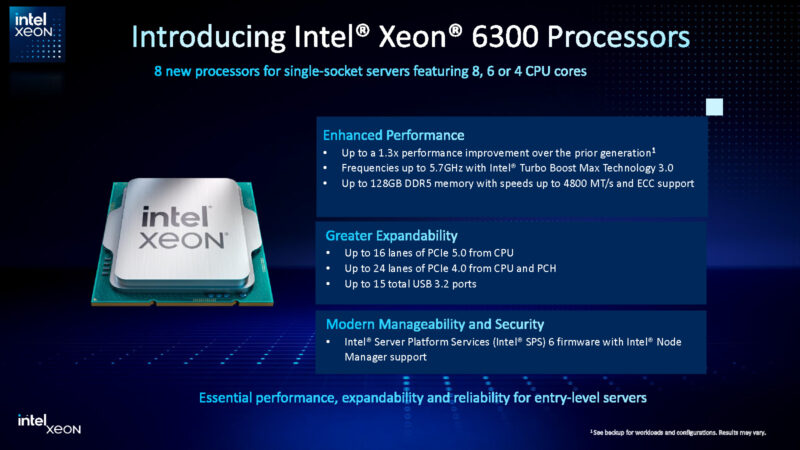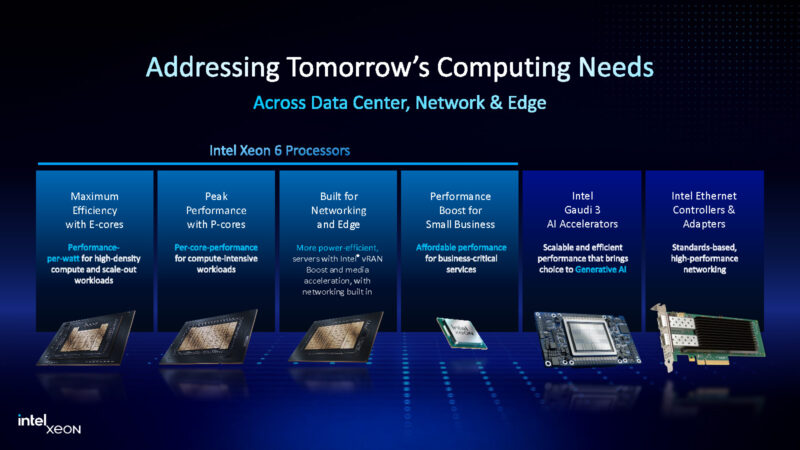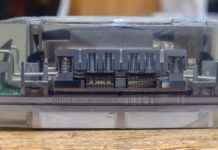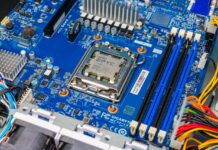The title of this one might be harsh, but this launch is nothing short of perplexing. Last week, we saw Lenovo updating its servers with Intel Xeon 6300 series. The Intel Xeon 6300 series is the new entry-level server CPU based on P cores. This is one of the more bizarre launches we have seen Intel make.
Intel Xeon 6300 Launched for Entry Servers with 2019 Core Counts
Intel says the new processors can hit up to 1.3x the performance of the previous gen series. To be clear, both are Raptor Lake designs so this is more of a refresh of the Xeon E-2400 and a rebranding rather than a new line.

Editor’s Note: We looked up that 1.3x performance claim footnote. Intel was using a Xeon E-2314 to Xeon E-2414 comparison, so the Xeon 6300 series is such a thinly veiled branding refresh that the performance comparisons are not differentiating the Xeon 6300 series and Xeon E-2400 series.

Here are the SKUs. We can see that the maximum turbo clocks are 5.7GHz which is very high. These SKUs still support two channel DDR5-4800 ECC memory which is not exactly the top-bin. Also, the “Max Scalability” is listed as 2S, but we think it should be 1S. We asked Intel, and Intel confirmed. We will update the slide when we can.

The overall details are fairly light on this one, but it is probably right to think of this as the Xeon E-2400 series update.
Final Words
Every time I have seen these slides, all I can think is that this is almost a launch to align naming conventions so instead of the Xeon E series, there is now a Xeon 6300P. Intel needs to hope that AMD does not launch a Zen 5-based EPYC 4000 series this year. AMD already has a 16 core Zen 4 EPYC 4004 series processor. That 16-core AMD offering matches Windows Server 2025 16-core license packs, which is a big deal for many SMB customers.
It just feels like Intel has given up in the entry Xeon space. We discussed this recently in our recent The Intel Xeon E Challenge in 2025. This is not the big dollar segment of the server market, so it often does not get a lot of focus. Still, with this Xeon 6300 series launch, AMD has a clear segment to go after for adding volume market share.

It feels like Intel knows this. The two Xeon 6300 slides above were not presented in the pre-briefing call. Intel needs a reset in this segment because this seems like a “nothingburger” of a launch.





So this my First time commenting so please be gentle.
I think your right Mr. Kennedy. I think this is just a rebrand of what might be raptor lake or alder lake Silicon because in the Xeon product brief on Intel’s website it says that the processors are built on intel 7 (As of 2-24-2025 @ 11:33am est)which if I remember correctly all the new processors are built on intel 3 with only the I.O. tile being on intel 7 or intel 4 for some products. It also says its lga 1700. I don’t know if there is the igpu included or if the e-cores are included but just fused off but it seems to me that rather then purchasing this platform it would just be better to get a W680 motherboard and use the consumer cpus Since the platforms seem almost identical except you get more cores and the built in gpu accelerators for extra flexibility and around the same price if not cheaper and Raptor and alder still seem very competitive with zen4 based cpus with a bios update to avoid potential cpu death.
Also I don’t know how much the boards cost for this platform but depending on the cost of the boards for LGA 4710-2 would it not just be better to get the lowest end 6500 series with is double the cores for about double the prices plus all the included accelerators, huge number of PCIe lanes and great core count upgrade support in the future especially when the chips hit the secondary market? Not to mention the list retail price for the highest end EPYC 4004 is not that much cheaper then Xeon 6500 (Which I know is not very representative given the respective time in the market). I guess the question would be what is the performance/$ for the 6500 series vs the EPYC 4004 accounting for the accelerators that might make the cost more reasonable if you use them and the platform cost especially if the xeon 6500 could be overclocked reasonable on the boards?
This is not me trying to shill just trying to see if my analysis seems reasonable.
Correct me if I am wrong, but is the support for ECC the unique selling point here? Or perhaps the offering of vRAN with integrated networking the selling point for these (on the top end sku)?
These could also be binned chips specifically collected for their stability. Of course I have no idea if this is done or not, but the Xeon line has a much higher level of stability expectations.
The ECC support might be unique *for Socket 1700 CPUs*. AFAIK all Zen chips support ECC.
@snek:
ECC support is not unique. On mainstream Socket 1700 it’s supported on certain Core i5/i7/i9 CPUs if, and only if matched with the W680 chipset. The CPU design supports it, but it’s an artificial limitation by Intel for market segmentation.
16 PCIe lanes is absolutely unacceptable for any kind of server CPU these days. What were they thinking??
M – As noted in the above, this is effectively a Raptor Lake Xeon E-2400 refresh with a few hundred more MHz and a new banding and SKU numbers. On the 6500P series, that is a good point. Usually the motherboards are considerably more costly, and the TDP is notably higher so you end up with a starting system cost ~2x and power close to 2x by doing that jump, but we have not tested the 6500P series yet.
Heterogeneous product design teams are killing Intel in the high end consumer, entry level server segment. The segment looks totally lost to AMD and has been stagnant for years. They need a mid-range 32 P core design with X3D-like variants.
There are no G parts, correct? So nothing with integrated graphics with quicksync capability?
I think the point of these low core count server SKU’s is lost on many people – yes they are not great, but they exist for the enterprise software market where licensing is tied to core count. A big 32 core CPU would kill you on such a license model i.e Oracle DB, VMWare under Broadcom. In cases where you don’t need tons of I/O or performance, these low end parts fill a need on the edge or in light duty use.
Another good market these will end up in will be VPS providers with bare-metal options. Cheap, low power consumption, low expansion capability is OK.
AMD’s entry-level EPYC parts have not really found their way into mainline super-budget enterprise offerings. HPE’s DL20 would use these Xeon 6300 parts, but there is no DL25 for the matching Ryzen-based EPYC. Likewise, Dell’s R2xx and 3xx are Intel-only. There is no entry-level Dell SKU with AMD CPU’s. I don’t know why AMD can’t convince Dell or HPE to launch a server around one of these AM5 EPYC chips, it would be great.
One last thought…once these 6300 series machines age out, you will find them wander into homelabs. The old Dell R210 II was a popular mainstay years ago before it aged out to just firewall duty in most people’s labs. Quiet, cheap, low heat.
Jack wrote: There are no G parts, correct? So nothing with integrated graphics with quicksync capability?
Correct. These are raptor lake chips with the E cores and GPU fused off. They do this on purpose to make you also buy a GPU accelerator.
So here’s what you do: buy a raptor lake K chip (supports ECC) and use a W680 MB. Disable the E cores in BIOS if you want to install Windows Server. This system gets you both ECC and iGPU / quicksync. I’ve been doing this for multiple years now. It’s cost effective and it works.
Enjoy!